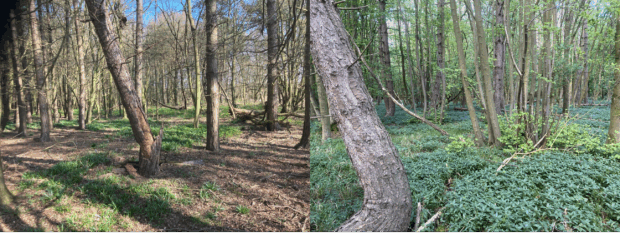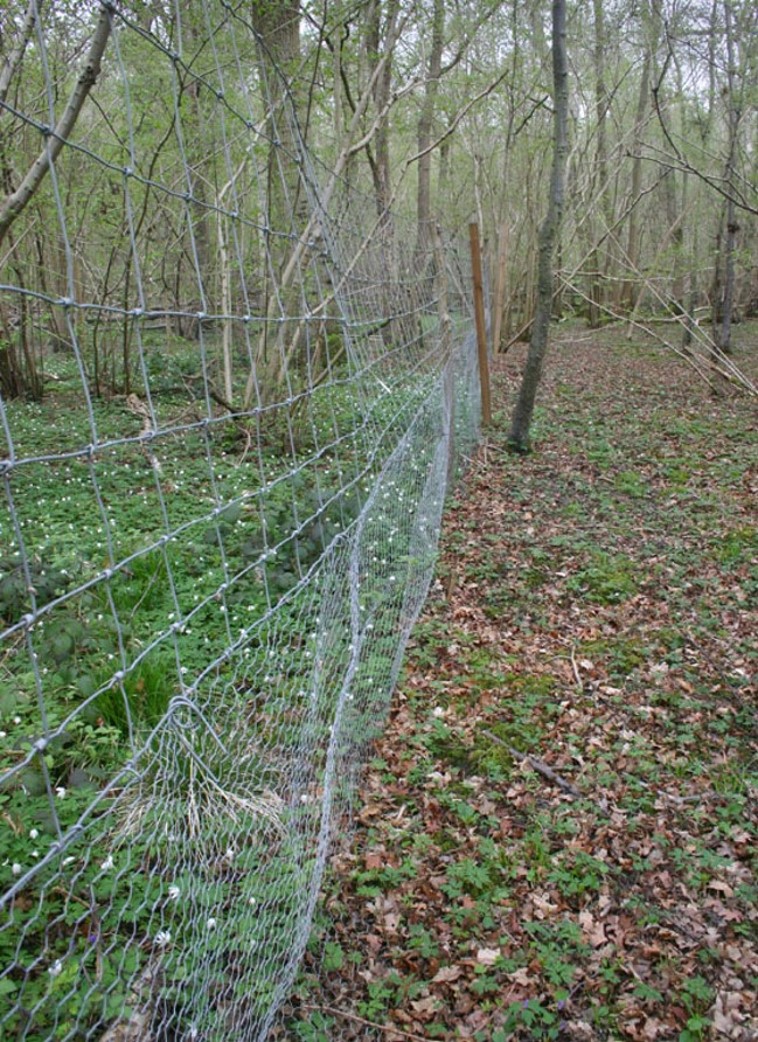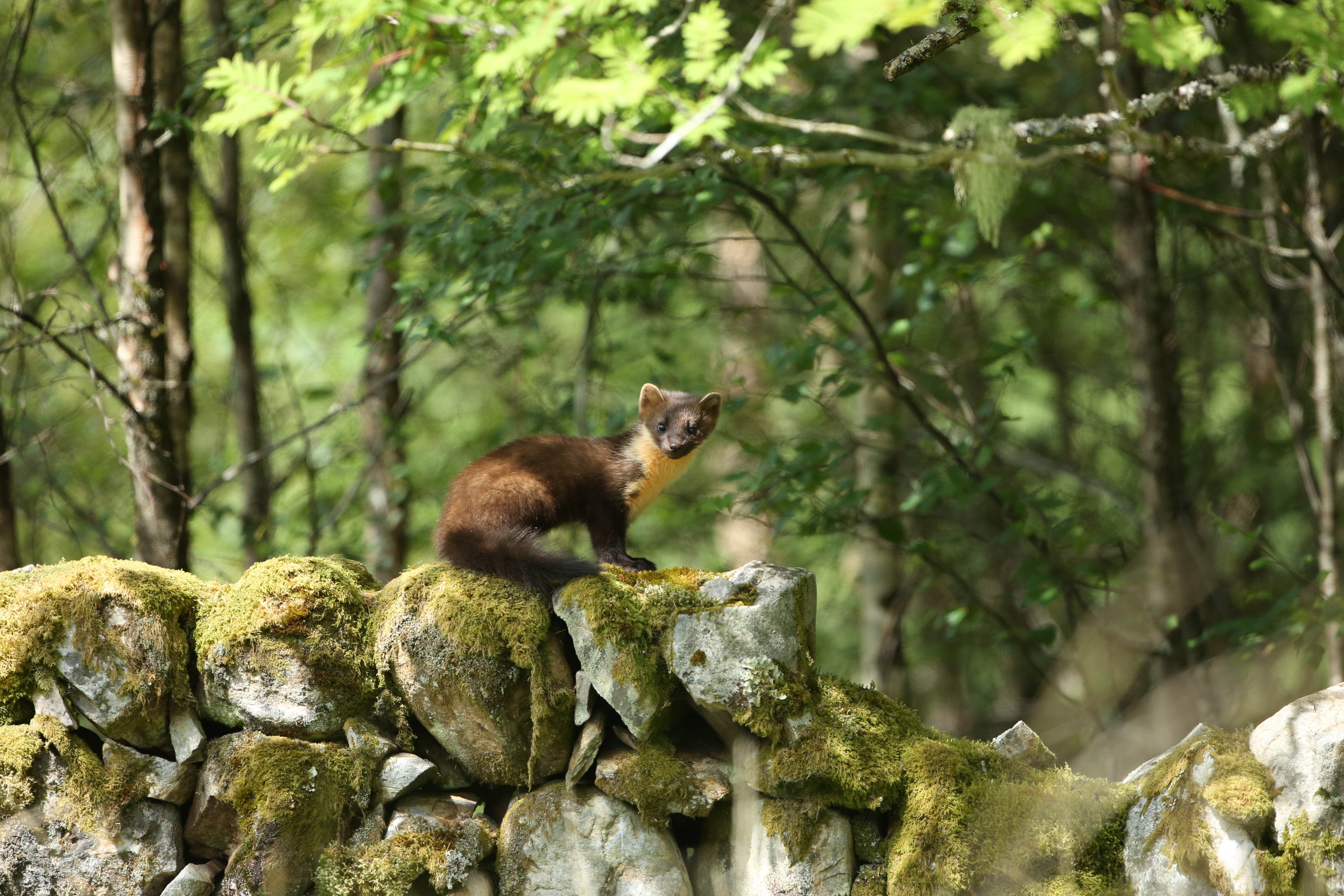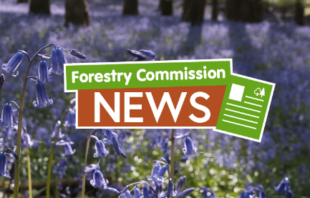 As part of National Tree Week, Anna Brown, Director of Forest Services at the Forestry Commission, and Alan Law, Chief Officer for Strategy and Reform at Natural England, reflect on the work happening across the sector to reduce the impacts of deer and squirrels on England’s woodlands.
As part of National Tree Week, Anna Brown, Director of Forest Services at the Forestry Commission, and Alan Law, Chief Officer for Strategy and Reform at Natural England, reflect on the work happening across the sector to reduce the impacts of deer and squirrels on England’s woodlands.
England’s woodlands are a vital natural asset. They provide habitat for native wildlife, support the timber industry, offer spaces for recreation and capture carbon. However, these ecosystems face significant threats from deer and the non-native grey squirrel.
Both organisations are working to manage the impacts through financial support, scientific innovation, increased culling effort and landscape-scale collaboration to protect woodlands.
Understanding the problem
The impact of deer
Heavy deer browsing prevents woodland creation by damaging newly planted trees and preventing, or slowing, natural colonisation. In established woodlands, it can destroy the understorey which degrades habitat for wildlife, stops regeneration and reduces resilience in the long term.
Heavily browsed woodlands grow more slowly, store less carbon and support fewer plant, invertebrate and bird species. This has clear environmental and economic consequences.
The threat of grey squirrels
Grey squirrels threaten our native red squirrel population though competition and disease transmission. They can also strip bark from trees, undoing years of careful woodland management.
Bark stripping slows growth, weakens branches and allows fungal diseases into the heartwood. In extreme cases, when trees are stripped all the way round the main stem, it kills them. This limits future timber use and can change woodland composition.
These problems are acknowledged across the sector and beyond.
Andy Leitch, Deputy Chief Executive of the Confederation of Forest Industries (Confor), says:
"We are pleased to see that government recognises the damage deer and grey squirrels cause to timber production and tree establishment. Deer can be managed through sustained local and landscape effort, but grey squirrels require more robust action and research into eradication tools to enable red squirrel recovery.
Without progress, growing quality oak and beech to supply the timber needs of future generations will remain nearly impossible. We welcome the actions taken by the Forestry Commission and Natural England and urge them to continue to work with us and others to control these populations to minimise impacts on establishment costs and quality timber production."

Our response
The impacts of grey squirrels and deer on woodlands are well documented. We know that a balanced, long-term approach is essential for the health and resilience of England’s trees and woodland biodiversity. Here is just some of the work happening across the sector:
Financial support for woodland owners
We introduced deer and squirrel management supplements into Countryside Stewardship in 2022 to help woodland owners and foresters offset the cost of managing the impact of deer and squirrels.
The grants offer flexibility: from applicants funding professional wildlife managers for lethal control to capital investment in infrastructure and equipment such as high seats and humane squirrel traps.
Since launch, over 900 grant agreements have been signed, increasing resources to reduce deer impacts on 65,000 hectares of woodland and grey squirrels impacts on 55,000 hectares. We encourage all woodland owners to consider these grants where eligible (now under PA7, CWS1 and CWS3).
Christopher Williams, CEO of the Royal Forestry Society (RFS), says:
"The RFS and its members prioritise effective deer management and squirrel control. With fewer deer, our woods can regenerate, become better havens for wildlife and grow more resilient to pests and diseases. Controlling grey squirrels is essential for growing good quality hardwood as well as protecting native biodiversity.
This grant support has inspired many of our members to better plan and deliver management on their land. However, isolated activity will not achieve lasting impact, effective action requires a landscape-scale approach. That’s why the sector is working together to encourage wider uptake of the grants and greater collaboration."
Landscape-scale deer management
Wild deer, particularly herding species such as fallow, red and sika, can cross several properties in a single day, making collaboration between landowners essential for effective management.
Projects like the Sussex Woods Pilot, managed by Natural England, bring together many landowners to understand deer numbers and impacts, coordinate culling, provide training and develop initiatives such as venison marketing schemes to provide healthy locally sourced meat.
Steve Walker, Project Coordinator of the Sussex Woods Protected Site Strategies Pilot, says:
"Landowners are much more likely to work together and prioritise deer management when presented with accurate data on local deer numbers and the true economic and environmental cost of deer damage to woodlands and crops."

Knowledge sharing and building capacity
Forestry Commission Deer Officers reach thousands of people each year through large events such as the National Deer Conference (attended by over 300 people in 2024) to local workshops and one-to-one advice for woodland owners, agents and managers.
Sharing successes and failures is essential to improving deer and squirrel management nationally. Deer management is often solitary work, so bringing professionals and recreational stalkers together is an effective way of enabling knowledge exchange.

Supporting the Squirrel Accord
The Forestry Commission and Natural England, along with 43 other organisations, are signatories to the Accord, which aims to protect red squirrels and broadleaf trees from grey squirrel impacts.
Through dedicated Squirrel Officers, the Accord increases grey squirrel management across woodland areas. Officers work with landowners and volunteers in Yorkshire, Lancashire and County Durham, close to England’s few remaining red squirrel strongholds.
Kay Haw, Director of the UK Squirrel Accord (UKSA), says:
"The Forestry Commission is a vital partner providing expertise, funding and support to UKSA. Including funding a project to expand grey squirrel management in Yorkshire, Lancashire and County Durham.
This initiative is generating action across over 565,000 hectares of land by engaging nearly 5,000 stakeholders, creating six new community action groups and training over 200 volunteers. Working together we aim to find solutions that better protect our trees, woodland ecosystems and red squirrel populations."
Embracing technology and innovation
Advances in night vision and thermal imagery have enabled more accurate population surveys. Drones with thermal cameras are increasingly used across estates and in landscape-scale projects to reduce deer and squirrel impacts, whilst night vision helps deer managers increase their effectiveness within current legislation.
Research into grey squirrel fertility control, conducted by the Animal and Plant Health Agency and facilitated by the UKSA, could provide a longer-term alternative to lethal control.

Developing the venison supply chain
Culling of wild deer not only improves our woodland resilience, but it also provides a nutritious and healthy source of protein, and the only climate positive red meat in the form of wild venison.
We have been working with Grown in Britain, Approved Game Handling Establishments and others to build confidence in the venison supply chain. The resulting British Quality Wild Venison (BQWV) standard provides the assurance that the venison produced under this scheme has come from humanely culled deer, carefully inspected and prepared for the food chain immediately after shooting, then stored and transported in climate-controlled facilities.
Dougal Driver, CEO of Grown in Britain, says:
"The BQWV scheme delivers confidence to new markets in wild venison as a highly nutritious source of protein. By driving demand, we support landowners to deliver better land management, resulting in improved outcomes for our woodlands and natural habitat."
Increasing demand for wild venison helps offset deer management costs whilst providing a sustainable and healthy source of free-range meat. Various organisations, including hospitals and universities, are using venison more frequently and feedback has been positive.
The Royal Society for the Protection of Birds (RSPB) supports maintaining deer populations at levels that enable healthy, functioning ecosystems and sees a growing wild venison market as key to achieve this balance.
Andrew Weatherall, Principal Policy Officer (Woodlands and Forestry) for the RSPB, says:
"We support well-informed deer management carried out humanely and ethically. Where deer populations are in balance with the wider environment, woodland birds benefit from the resulting understorey and plant communities. Good quality wild venison is a fantastic byproduct of this part of habitat management that society can make good use of."
Managing the nation’s forests – Forestry England’s vision for the future
- Forestry England is launching its first ‘Vision for Wildlife Management’, setting out how they will increase deer and grey squirrel culls to protect timber production and forest health. This vision sets out plans to continue building a highly skilled professional wildlife management team, strengthen expertise and capacity, increase the strategic use of contractors, enhance engagement with licensed control methods and expand volunteer involvement
- pine marten reintroduction: after decades of absence, pine martens are returning to the nation’s forests through natural expansion and targeted reintroductions. Forestry England is a lead partner in successful projects in the Forest of Dean and has confirmed a breeding population in the New Forest through camera trap and thermal imaging studies. Reintroduction projects led by others, including the South Cumbria Pine Marten Project and Two Moors Project in Devon, aim to establish self-sustaining population outside the nation’s forests
- larder investment: in 2024/25, Forestry England’s wildlife teams culled nearly 18,000 deer, a 10% increase on the previous year. They are investing in the redevelopment of their larder facilities to support this activity and maintain their position as the country’s leading producer under the BQWV scheme

Deer licensing reform
Shooting deer at night is normally unlawful but night shooting can increase culling efficiency, particularly for herding species that move into fields after dark.
Currently, individuals must apply for night shooting licences for specific land areas and demonstrate that daytime shooting cannot resolve the damage. Natural England has reviewed how these licences are issued and is introducing a lighter-touch licensing regime to support wider use of night shooting.
People will be able to register for a night shooting class licence if they meet training and experience requirements. The new approach is currently being tested with Forestry England rangers, with plans to offer it to all deer managers in early 2026.
Working together for England's woodlands
The challenges posed by deer and grey squirrels require action at every level, from policy and innovation to practical management on the ground. Ultimately, success or failure to reduce deer and grey squirrel impacts nationally rests with woodland owners making decisions to work with their neighbours, increase cull efforts and use government support to help achieve this. Without collective effort, these species will continue to undermine efforts to improve farming and forestry economics, restore nature and mitigate climate change.
We celebrate everyone contributing to this effort: landowners and managers, Squirrel Accord and Deer Initiative Partnership members, professional and recreational deer managers, game keepers, game dealers and consumers choosing British Quality Wild Venison. Your work directly supports the health of England's woodlands and the benefits they provide to us all, and we encourage you to both continue and expand your efforts.



17 comments
Comment by Silvana Bushi posted on
Wow I never knew that deers were so bad
Comment by Derek Grffiths posted on
Maybe if the game industry stopped supplementary feeding the millions of non natives birds the squirrels wouldn't have free food in abundance,the cessation of game bird hunting would benefit the ecosystem immensely.
Comment by Steve Bell posted on
Your case against deer browsing much needed woodland is understandable but I do not see the necessity to destroy small herds completely which is happening in Rother Valley.
Comment by Forestry Commission posted on
Thank you for raising this local concern. Our approach aims to reduce deer populations to sustainable levels that allow woodland recovery, and not to eradicate herds entirely.
Comment by Ian Mackay posted on
It’s not deer and squirrels that are the problem, it’s humans.
Comment by S. Joy McCarthy posted on
At last, how soon can was access some help to save our woodland?
Comment by Forestry Commission posted on
Thank you for your question. You can find further support and information on our grants, as well as signing up to our eAlert for the latest news on grants direct from us.
Comment by Joy McCarthy posted on
I was extremely pleased to see I'm not alone on my anxiety about my woodland deer and grey squirrel damage and the long term effect with regard to climate breakdown
Comment by John Hayes posted on
Very informative and interesting.
Good to know this happening.
Thank you.
Comment by Patrick Cannon posted on
The general public need educating so that they understand grey squirrels are not harmless cute fluffy animals. My local woodland is full of greys to the detriment of many passerine birds.
Comment by Hans-Peter Verhoeven posted on
One problem that discourages new stalkers is that game dealers only accept head/neck shot deer increasing the chances of wounding and a distressing conclusion to a stalk.
Comment by Forestry Commission posted on
Thank you for your comment. We recognise that different game dealers have varying requirements. We're working with the industry through the British Quality Wild Venison scheme to develop more consistent standards that support humane culling practices whilst maintaining meat quality. For best practice guides, visit: https://thedeerinitiative.co.uk/guides-landing-basc/
Comment by Richard posted on
The Isle of Wight is reputed to have neither deer nor grey squirrels on board. Going for a walk in the woods there is more like a "ramble in the brambles".
Comment by Glenn Dryer posted on
A great and very positive article.
I am a qualified and experienced deer stalker and competent with an air rifle when it comes to shooting squirrels,
Have the authors tried to obtain deer stalking and woodland management permission?
Until there is some sort of formal obligation on land owners/land managers the rest is a waste of time.
I am presentable, polite, competent and available so why is it so difficult?
I now live in NW Wiltshire so all the land owners/land managers in my area with deer or squirrel issues, please contact me.
(Sadly I don’t expect to hear from a single person but, we’ll see)
Comment by Forestry Commission posted on
Thank you for your comment. The British Association for Shooting and Conservation (BASC) provides an opportunity for deer stalkers with relevant qualifications to register with them. BASC will then email deer stalkers in specific areas if an opportunity arises.
Comment by Dr John Jackson posted on
The IOW now has resident wild deer populations and a deer park and deer have been seen swimming the Solent.
Try a google search. There may also be a deer group that is actually in favour of having more deer there, to the detriment of the ground flora.
Comment by Andrew Chatfield posted on
If the Government was really looking at the deer problem they would not be making the requirement for lead to be replaced. Controlling Muntjac is essential for woodland management and the returns on carcasses is minimal. With a fourfold increase in the cost of lead free bullets shooting is not cost effective and who has died from eating lead shot game? I haven’t ever heard of it as a cause of death or illness. Then there is the question of over-penetration of nontoxic alternatives put together with night shooting which is a recipe for disaster